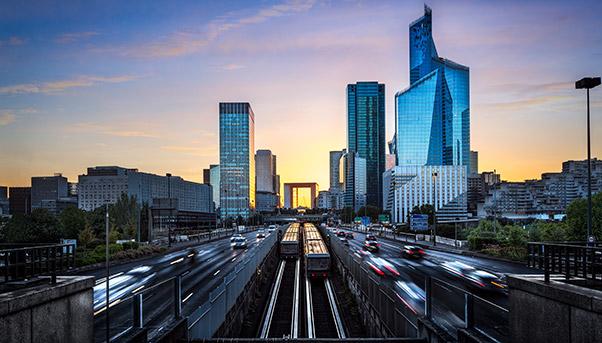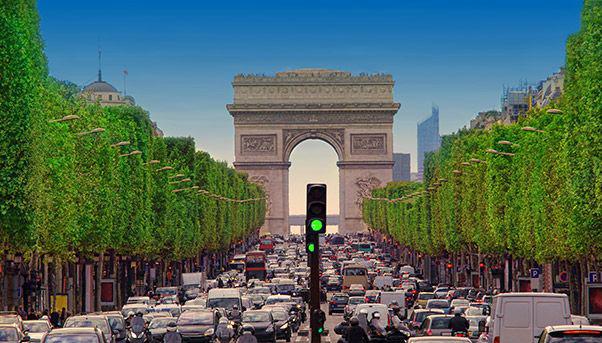
In 2016, Paris reached a turning point just a few weeks after hosting the United Nations World Climate Change Conference: it decided to go “green”.
The city – as well as the national government – decided to take up the challenge of turning itself into a carbon-neutral city by 2050 and prove to the world that a metropolis of several million inhabitants could reduce emissions of harmful gases by 80%.
The final go-ahead came on March 21, 2018 when the city approved an
ambitious and difficult plan to become 100% powered by renewable energy.
With the support of the national government, it pledged to implement
500 “green” initiatives in the coming years, from transport to
construction, from public parks to trade, from garbage collection to
water management.
The aim was – and still is – to reduce emissions by an annual average of
3%, bringing the city to an intermediate goal of having them down 50%
by 2030.
Goodbye to cars, hello to rail
One of the most effective ways of cutting emissions, of course, is to find new mobility solutions. Every day, 1.1 million Parisians move around the city. Then there are the 220,000 tourists to consider. According to the study “Paris, an Air of Change” commissioned by the city, every year people in the city travel eight billion kilometers throughout Paris, each covering an average distance of 4,000 kilometers. About two thirds of that distance, or 60%, is covered by using public transport, a percentage that must increase in the future. Public transport will receive a huge boost from the Grand Paris Express, the rail and metro network extension under construction that is one the largest sustainable mobility projects in the world. The new lines of the Grand Paris Express, whose cost could reach up to an estimated €30 billion, will have a strategic impact in reducing emissions because they will connect the suburbs to the city centre, offering rail transport where it had been lacking. The commitment to strengthen rail transport is expected to reduce the use of cars, which is seen falling from 600,000 to 300,000 by 2050. To achieve this result, the city has already approved a series of measures that discourage the use of cars: from 2024, diesel vehicles will no longer be able to circulate. This block will be extended in 2030 to all internal combustion engines. The future will therefore be electric, but, above all, alternative forms of transport, from bicycles to subways.
Making the buildings of Paris more green
Another area that the city is targeting is real estate: be it the home or office.
There are 1.4 million homes, which occupy an area of 80 million square
metres and are responsible for 20% of carbon dioxide emissions. Energy
consumption is naturally very high. The study “Paris, an Air of Change”
calculates that Parisians consume 12,100 GWh of energy each year, with
an average of 5,400 KWh per single inhabitant. This number rises when
office buildings are included, which occupy an area of 59 million square
meters in the French capital.
The city therefore has decided to mount a big push to make existing buildings more energy efficient.
The first renovation project was launched in 2014 and will finish next
year, after which 40,000 homes will have undergone energy renewal and
been upgraded to the most modern conservation standards. From
2019 the focus will shift to the maintenance of public buildings, which
in turn will be followed by the renovation of one million private homes
by 2050.
The other path taken leads to energy self-sufficiency. In fact, a project is already underway to install rooftop solar panels. According to the city’s forecasts, by 2050, panels will be installed on 20% of buildings in Paris (that is six million square metres of rooftops).

Changing the way goods are delivered
In a large city like Paris, the transport of goods is quite complex
and consumes vast amounts of energy. Every year, 6.5 billion tonnes per
kilometre of goods are moved, two thirds of which entering the city,
while the remaining third is transported elsewhere.
The least-polluting option is transport by water on the Seine, followed
by rail. And it is along these two lines that the city is working to
create a more modern freight transport system, which minimises the use
of trucks and vans, thereby reducing both emissions and traffic
congestion. Currently only 7% of freight is moved through Paris by rail,
according to the city, which aims to increase that amount to 34% by
2050.
Paris wants to join the “green” leaders club
The first major testing ground for the French capital’s green ambitions will be the 2024 Olympic Games. The Games will not only be a world showcase for Paris, but an opportunity for dress rehearsals to showcase an urban system capable of growing and functioning hand-in-hand with the environment. According to the International Olympic Committee, the Games will be the first ones organised with the aim of reducing carbon emissions as much as possible. That is why they have already been dubbed the “Paris Low-Carbon Olympic Games.” The entire Olympic village, as well as many of the competition sites, will be set up along the Seine, near one another and in the city centre. In addition, the new buildings will be constructed according to the most modern environmental standards.
This is a must for a Paris that, like few other cities in the world, has chosen the path of sustainability. Together with the French capital, a group of other cities are leading the green revolution around the world. San Francisco, New York City and London all intend to reach 2050 with an 80% cut in emissions. Vancouver even aims to totally eliminate fossil fuel emissions.
This commitment is supported by the European Union. On November 28, the European Commission approved a long-term package of measures to reduce harmful emissions to zero by 2050 in all EU countries.
To succeed, the Commission calculates that investments in clean energy must rise from 2% to 2.9% of the EU’s gross domestic product. This is a shared challenge to modernise not only a city, but an entire continent.

